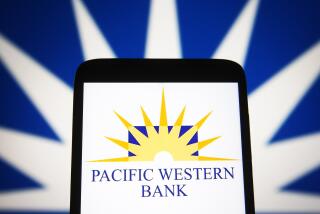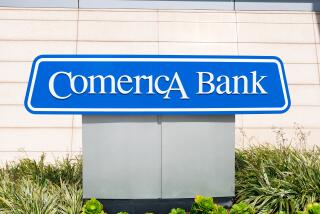First Interstate Covering Big Losses at Texas Bank : Third-Quarter Loss Likely to Top $100 Million After Putting Up $180 Million for Subsidiary’s Bad Loans
- Share via
First Interstate Bancorp said Thursday that it will set aside a surprisingly hefty $180 million for loan losses at its Texas bank and shift $400 million in non-performing loans to a so-called bad bank.
The separate actions will result in a third-quarter loss “much in excess of $100 million,” but earnings should improve sharply in 1989, Joseph J. Pinola, chairman and chief executive of the Los Angeles-based banking company, said in an interview.
Analysts estimated that the third-quarter loss will be in the range of $150 million to $200 million. Earnings for the first six months of the year were $199.8 million, and Pinola said the company still expects to end 1988 in the black.
First Interstate was forced to disclose details about the two maneuvers prematurely when its stock price plummeted in early trading Thursday on the New York Stock Exchange. The decline came after some industry analysts reduced their estimates of the company’s 1988 earnings.
Kidder Peabody and C. J. Lawrence, two New York brokerage houses, cut their projections of First Interstate’s profits because of concern about higher-than-expected losses at its Texas bank, according to traders.
Heavy Stock Selling
Another New York brokerage house, Smith Barney, Harris Upham & Co., advised clients not to buy First Interstate stock until details of its “bad bank” spinoff were announced.
The effect of the recommendations was heavy selling of First Interstate and few buyers, driving the stock price down. At one point Thursday, the stock was down by $3 a share and trading was twice as heavy as normal. It ended the day at $48.50, a drop of $2.50.
“We were in a situation where we had to make an announcement,” said Don M. Griffith, the chief financial officer of First Interstate.
The surprising part of Thursday’s announcement was the additional $180 million set aside to cover the deteriorating real estate loan portfolio at First Interstate Bank of Texas. The Houston-based company, formerly Allied Bancshares, was acquired earlier in the year by First Interstate.
Acquisition of the troubled Texas bank was viewed by some analysts as risky, and rumors about the need to add more to loan-loss reserves has caused concern in some quarters recently.
“We are happy with the management of the Texas bank and with the beginning of the turnaround in the economy there,” said Pinola. “Obviously, we are not happy with the deterioration of the assets.”
Real estate values have kept dropping in Texas despite signs of an economic rebound. Part of the reason is that banks have begun returning foreclosed real estate to the market in response to the slight economic upturn, driving values down.
The part of the announcement that was not a surprise was the spinoff of the bad loans into a new entity, which will be passed along to existing First Interstate shareholders in the form of a dividend. The deal will be completed in early 1989.
The $400 million in bad loans represents 20% of the non-performing loans in the portfolio of the bank holding company. First Interstate has $58 billion in assets and operates banks in 13 states, including First Interstate of California, the state’s fourth-largest bank.
Nearly a year ago, First Interstate disclosed a massive restructuring plan aimed at jettisoning businesses that were losing money or only marginally profitable and trimming about 1,000 jobs. Part of the plan was to transfer $400 million in bad loans to a new entity.
Unlike Mellon Bank Move
The good bank-bad bank concept basically involves taking the worst loans and shifting them to a new entity. It has been used several times in recent years in acquisitions of troubled banks, including First Interstate’s takeover of Allied.
It was first used by a healthy bank last July when Mellon Bank of Pittsburgh announced a plan to sell $1 billion worth of bad loans to a new entity. Since then, Mellon’s stock has dropped nearly 15% as a result of concerns about the financing of the transaction.
Part of the market’s jitters Thursday were caused by the misconception that the First Interstate spinoff would be similar to that of Mellon Bank.
But rather than selling the loans, First Interstate is transferring its bad loans to a new entity that will provide some value to shareholders. The bank will raise replacement capital by selling an undetermined amount of preferred stock.
Thomas H. Hanley, chief banking analyst at the New York investment house of Salomon Bros., believes that the bad bank plan will give a big boost to First Interstate’s earnings next year. He recommended late Thursday afternoon that his clients buy the stock.
“This was basically in line with what the management had been saying,” Hanley said in an interview. “Now First Interstate has cleared the deck in terms of credit quality and we feel confident about the 1989 profit prospects.”
First Interstate executives were still working on the plan when Thursday’s action on Wall Street forced it to go public with the details that had been worked out so far.
Griffith said a final decision has not been made on which shaky loans will go into the bad bank, but he said the bulk of them will be real estate loans from California and Colorado.
Unable to Sell Unit
The Internal Revenue Service has given First Interstate favorable rulings on the tax benefits of the spinoff, which allowed the plan to move ahead, said Griffith.
The bank will have to set aside additional loan-loss reserves or reduce earnings in the third quarter to cover the $400 million in bad loans when they are marked down to market value. But Griffith said the amount of losses has not been determined. It is expected to be in the neighborhood of $100 million.
First Interstate had hoped to raise enough money to offset the $400 million by selling its mortgage-serving operation and its half interest in its headquarters building in downtown Los Angeles. However, the company has been unable to sell the mortgage unit and the bank building came off the market following a disastrous fire on May 4.
Pinola said the bank will no longer be actively pursuing a buyer for its mortgage-servicing unit, although he said it would still be sold for the right price. The building will not be back on the market until repairs from the fire are completed.
GOOD BANK, BAD BANK
Here is how the good bank-bad bank concept will work at First Interstate:
- $400 million in bad loans will be moved from First Interstate units to a separate entity, the “bad bank.”
- As part of the move, the loans will be marked down to market value, creating a loss for First Interstate.
- The loss will be made up through existing reserves, new reserves and writeoffs against income in the third quarter.
- First Interstate shareholders will become stockholders in the bad bank through a dividend in early 1989.
- First Interstate hopes to benefit from a cleaned-up loan portfolio and stronger earnings in 1989.
More to Read
Inside the business of entertainment
The Wide Shot brings you news, analysis and insights on everything from streaming wars to production — and what it all means for the future.
You may occasionally receive promotional content from the Los Angeles Times.










